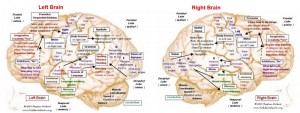So I’m watching something on TV, I don’t remember what, because I don’t do a lot of it, and pretty much every commercial break there’s an ad for Lumosity – “using the science of neuroplasticity!” This drives me nuts, because not only does it not work (more on that later) but it promulgates a failed understanding of what neuroplasticity is and what are its potentials and limitations.
There is nothing magical about neuroplasticity. It’s a lot like corporeal plasticity, except that it’s all hidden and mysterious and thereby ripe for exploitation. Your brain, like the rest of your body, is comprised of physical parts that perform certain functions. Some parts are part of a team, and damage can be mitigated to a certain extent by training the other players to take on some extra tasks. Most of the time, these are motor skills, not cognitive skills. Some are star players, and if you take them out, everything falls apart, and nobody else is capable of bringing the team up to speed. Some are solo acts, and if you take them out, the game is over.
In a lot of ways, damage to your brain can be looked at like damage to your body. If you lose a body part, or lose use of it, you may be able to compensate somehow, but it still won’t be the same. Lose your dominant hand, and you can learn to write with your other. Lose your lower legs, you can get prostheses. But if you break your spine or lose your eyes, compensation gives way to compromise. Neuroplasticity isn’t going to replace damaged or missing neurons with new ones, and that’s just the way it is. There’s some small possibility that over 15-20 years, a couple might be replaced with working cells, but it’s just not going to make much of a difference.
To give you some idea of the vast gulf between what neuroplasticity can accomplish versus what folks who are selling it say it can, take a look at this video of a young woman who had a stroke that devastated Broca’s Area in her brain:
Now watch her three years later, after intensive rehabilitative therapy. Keep in mind, that as a young woman, her potential for recovery is higher than it would be for an adult:
This is merely one example. The cases in which recovery of this level or none at all outnumber the miraculous comebacks by an order of magnitude. (In fact, most of the miraculous comebacks involve misdiagnosis of something as being more serious than it was, or recovery of a nearly entirely physical function.)
The neuroplasticity that Lumosity is trying to sell, though, is even more magical than this. It is the neuroplasticity that allows learning. . .and that, too, has its limitations. Learning creates new networks of connections between neurons and groups of neurons, and the more a task is repeated, the better the chance that it will be learned and retained. The more the skills learned from the task are applied to other tasks, the more potential there is for additional neuronal network connections.
This happens to us at an incredible rate during the first three years of life, then slows down significantly during adolescence. The older we get, the more effort it takes to learn a new skill or task, especially if it is unrelated to one we have already learned. If it’s connected to something else, there’s a much better chance of us taking something new and actually forming a new neuronal network connection.
However, simple brain exercises like solving a particular type of puzzle or doing certain mnemonics or practicing memorization exercises don’t do this. What they do do, is teach you how to do that one individual task. Overwhelmingly, people who participated in studies of various “brain training” programs who took intelligence tests before and after the programs showed improvements equal to simply taking the same test on different days without the programs.
So learning a new mental task doesn’t automatically make you smarter or give you some neuroplastic booster. The most important thing you can learn from these brain-training programs is that spending hundreds of dollars on them doesn’t make you smarter.
